Three Minute Record: Gary "U.S." Bonds, "Quarter to Three"
the people were dancin' like they were mad
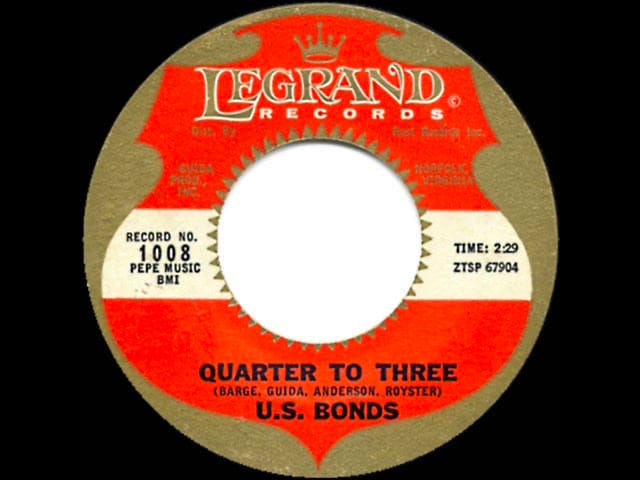
Welcome to Three Minute Record, the edition of this newsletter where we dive into Bruce Springsteen’s best cover versions. You can read more about the purpose of this exercise here and see other volumes here.
The first documented occurrence of Bruce Springsteen and the E Street Band performing Gary “U.S.” Bonds’ 1961 hit, “Quarter To Three,” was at Avery Fisher Hall at New York City’s Lincoln Center on October 10, 1974. As you enter the Lincoln Center plaza, facing the fountain, Avery Fisher Hall -- now David Geffen Hall, because Geffen donated $ -- is the building on your right. It normally hosts the New York Philharmonic Orchestra (and was called Philharmonic Hall until 1973 when -- you guessed it -- Avery Fisher donated $), and has featured jazz and rock and roll and other popular music over the years. Miles Davis played there, as did Bob Dylan. 1
We honestly do not know if this was the cover’s first appearance or how many times it popped up later, because we barely have an accurate listing of concerts played in those days, much less tapes or accurate validated setlists. Most of the shows took place at colleges or universities, which were not exactly known for their great recordkeeping with regards to whatever bands were booked by the entertainment committee. Or we’re relying on peoples’ very faulty memories. But in going through what research does exist for the end of 1974, what we can deduct is that Bruce is moving towards a setlist construction that he’ll become known for, where he ends the show with oldies that align with the kind of music he was trying to make, or with original songs that feel and sound a lot like oldies, such as “A Love So Fine,” which later mutated into “So Young and In Love.”
If we go back to 1974 and look at the setlists we have documented proof of, Bruce was either ending shows with “A Love So Fine” or he was using it at the start of an end of show run: “A Love So Fine,” Elvis’ “Wear My Ring Around Your Neck,” and then “Quarter to Three.” In 1975, Bruce started working “A Love So Fine” into a run either starting or continuing with “For You”2 but also working in the Shirelles’ “Sha-la-la” and then “Quarter to Three.” Chuck Berry’s “Carol,” the Drifters’ “Up On The Roof” and the ever popular “Twist and Shout” -- which is of course originally done by the Isley Brothers but Bruce’s version has always been loyal to the Beatles’ rendition -- make regular appearances as well. He’s trying to figure out what works.
What all of these songs have in common is that they were the kind of oldies Bruce and the band grew up on and, importantly, definitely spent time playing the shit out of in cover bands. They were all popular tunes that any cover band worth the booking was going to make sure they could play in their sleep. But the reason for their appearances at the end of sets was universal: they were how Bruce wanted to signify his band’s lineage as part of the history of rock and roll, and also to signify the continuity of the musical tradition they were part of. They weren’t country, they weren’t heavy metal, they weren’t folk rock, they weren’t singer-songwriters. They were a rock and roll band, period. The presence of the 50s rock and roll covers diminished in the set as Bruce wrote more and more of his own songs that accomplished the same thing as the oldies, and also, once you’ve been doing this for a while, you don’t have to keep reminding people why you are here. At some point you stop being the new kid on the block.
When “Quarter to Three” was released in 1961, it was a top ten hit, both in the US (#1) and in the UK (#7), despite it sounding like you’re listening to your friend’s band play through an analog telephone receiver. It felt like an accident, like you were listening in on a party as you walked by outside. It wasn’t perfect and polished, even if the whole “the audience is as loud as the band” bit was faked by the producer, who called in some local neighborhood kids to make party noises. All of these things made an already great song legendary, because “Quarter to Three” was already a barn-burner. You have the streetcorner doo-wop flavored harmonies acapella at the beginning, and in an era where everybody either sang with their friends or hung out with people who did, it sounded like a song anyone could sing. Then you have an insanely danceable rhythm, a hot sax player (courtesy the legendary Gene Barge, aka Daddy G), and then the dulcet tones of the singer, who sounded smooth as hell.
The singer, of course, was the man we now know as Gary “U.S.” Bonds. He was one of those kids singing on the street corners. Bonds sang in a group that called themselves the Turks and hung out singing in Norfolk, VA, a city that looms large in many musical stories because it had its own unsung music scene because of its central location and its proximity to Hampton Roads and a major naval base. There were a lot of people constantly coming through, and they brought their music with them and wanted to listen to music when they went out. Bonds was discovered singing out on the street. It is one of those stories that is honestly that simple.
Bonds began life as Gary L. Anderson, and sadly not as Ulysses Samuel Bonds, a sobriquet stated as fact by a British music columnist in 1961. In 1960, he recorded “New Orleans,” one of the greatest songs about a city that has had no shortage of anthems written in tribute to it, which went to #6. A year later, he recorded “Quarter to Three,” which went to #1, and then his producer wouldn’t let him out of his recording contract. (Sound familiar?) But you could make a lot of money on the road back then when you had two gigantic hits, and so that’s what Gary “U.S. Bonds” did (and still does! you can go see him right now!). Too many pieces about Bonds say things like “he disappeared” when you could go see him at just about any oldies package. He was a regular on the Dick Clark Caravan of Stars!
And that is how Bruce Springsteen went to see Gary “U.S.” Bonds one night in 1976, when Bonds was playing a New Jersey nightclub called the Hangar (or the Hanger) -- it had a plane on its roof because the original owner was a pilot -- on Route 35 in Hazlet. Route 35 is a major north-south artery for the Jersey Shore that ran from Rahway down to Point Pleasant (long-time readers may recall that the Shore Motel, home of the Pandemonium, previously featured on this site was also on Rt. 35). The Hanger had been a luncheonette for decades before becoming a disco called The Red Baron (and operating as what is euphemistically referred to by the local paper as a “go-go bar” in the daytime) and then was in the process of being renovated into a rock club called Sgt. Pepper’s when it burned down in 1979. 3
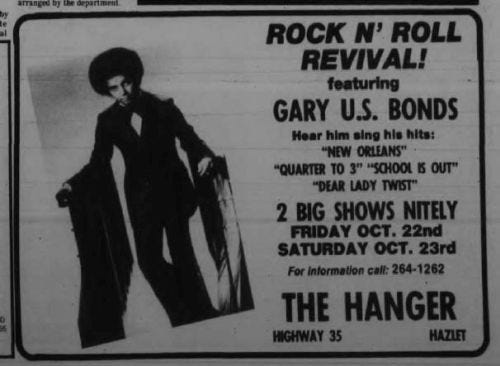

Let’s let Bonds tell the story about that night:
“No. I hadn't heard of him. He came to a club that I was playing -- in New Jersey, in fact. It was a place called The Hanger. It was on Route (35). He and some buddies came in while I was workin' there. A couple of his friends came up and said, ‘Is it OK if our friend comes up and does a few numbers?’ I thought, fine, I can go to the bar. So they told me his name and I introduced him. When I said, ‘His name is Bruce Springsteen,’ the crowd went wild.”
Springsteen and Steve Van Zandt would later work with Bonds to write, produce and play on two records that brought him back into the contemporary music scene. I’m personally extraordinarily fond of both Dedication and On The Line, but this essay is not about Bonds’ comeback. We are here to talk about “Quarter to Three,” and the moment when it rocketed into the consciousness of the greater community of rock and roll fans.
We are, of course, talking about the No Nukes movie.
I’m so sorry that the reissue of No Nukes happened during the pandemic, because everyone deserves the chance to see this moment on the big screen. There’s no denying that E Street’s appearance in the film was a definitive moment in their history, and all that is true and correct, but all of that drastically undersells the moment the movie cuts to “Quarter to Three.” Because in that split second it was champagne and fireworks and oh my god how is this guy even real. It was fucking rocket fuel. Bruce lit a match and the whole place went up in flames.
At this point in the evolution of the E Street Band and Bruce Springsteen as a band leader and live performer, “Quarter to Three” had evolved far beyond its origins, and had alchemized from a good time party song into a motherfucking ethos. The song remained in the set for as long as it did not just as a statement of intent, but also because it let Bruce and the band do what they did and execute whatever hijinks were required for any given situation, but it is fully Springsteen-ized at this point in 1979.
I can also make the case that this was what “Quarter to Three” was always meant to be. It is a party song, it is a golden oldie, it is connection, it is lineage, it is a pledge and a reminder. It is who they are, who they were, who they were meant to be. It was the fulfillment of a promise, it was the realization of years of dreams and ambition. And it mostly got put away after No Nukes, because he didn’t need it any more and had enough of his own songs that could serve the same purpose.
My personal favorite “Quarter to Three” that I got to experience and actually remember was at the final night at Shea Stadium in 2003. The end of the show was “Quarter to Three,” “Twist and Shout,” and “Blood Brothers,” and I danced in the aisles like my life depended on it, before E Street held hands at the edge of the stage and I wondered if I’d ever see them again.
Thanks to sources:
https://aberdeennjlife.blogspot.com/2015/08/history-state-route-35-south-at-gsp.html
https://www.nj.com/entertainment/2016/04/gary_us_bonds_jersey_connections_jersey_retro.html
And, as always, Brucebase.
Watching / Reading / Listening
- Watching: Dateline is back!
- Reading: Will Hermes’ Lou Reed: The King of New York
- Listening to: Gonna be in a Twilight Singers mode for a while
the stage collapsed: yes, there was a stage collapse during “Quarter to Three” but that was because the hall was in need of improvements and not the earliest example of Bruce Springsteen and the E Street Band breaking a concert venue. ↩
A odd choice thematically but it was a weirdly popular song ↩
Honestly I am over-researching on a scale that is ridiculous even for me, because some dumbass stated that Bruce met Bonds at a bar in Atlantic City and in the process of confirming that I was not misremembering the location of Hazlet I went down this research rabbit hole and because I was annoyed at bad scholarship, now you all get to benefit from it. ↩
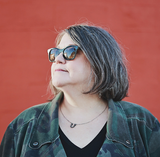
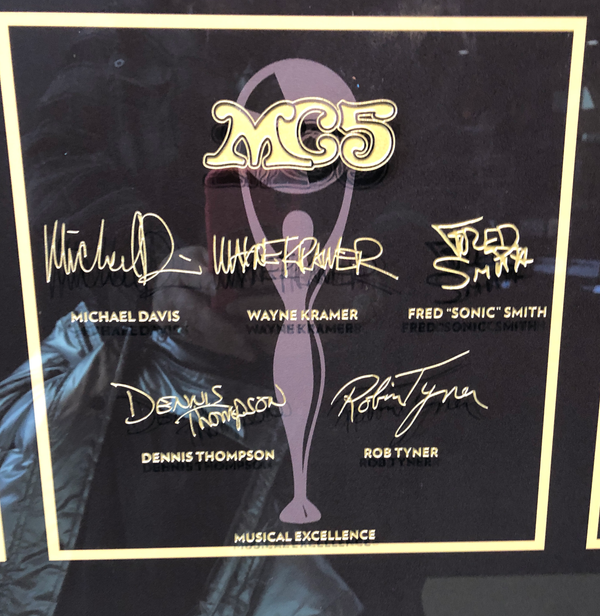
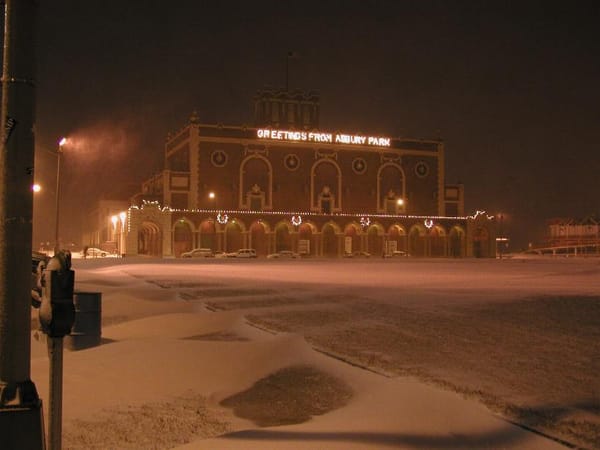
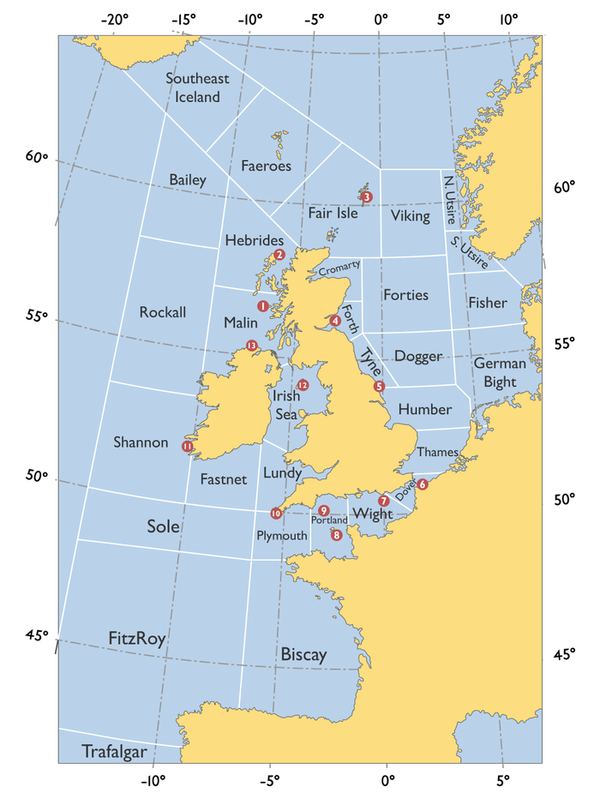
![remnants: Patti Smith and Her Band, Webster Hall, 29 & 30 December 2013 [+ bonus downloads]](/content/images/size/w600/2024/12/Screen-Shot-2024-12-29-at-2.13.07-PM.png)